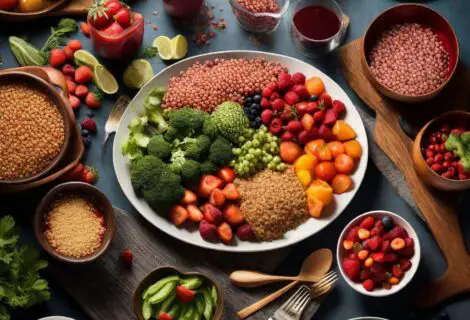How to Follow a Gluten-Free Diet: Tips and Meal Plan
[disclosure]
Introduction
Going gluten-free can seem challenging, but with some planning and creativity, it’s possible to enjoy delicious and nutritious meals. Here are some tips and a sample meal plan to help you get started with your gluten-free diet.
Why Go Gluten-Free?
Gluten is a protein found in grains like wheat, barley and rye. For those with celiac disease or gluten sensitivity, consuming gluten can cause a range of unpleasant symptoms including bloating, abdominal pain, diarrhea, constipation, headache, fatigue and skin rashes.
The most effective treatment for celiac disease is strict adherence to a 100% gluten-free diet. This allows the small intestine to heal and nutrients to be properly absorbed. Even small traces of gluten can be problematic, so vigilance is important.
Others may try a gluten-free diet to alleviate digestive or neurological symptoms suspected to be related to gluten intolerance. Going gluten-free for a trial period can help determine if you have underlying gluten sensitivity.
Top 10 Tips for Creating a Balanced Meal Plan
Tips for Following a Gluten-Free Diet
- Check labels carefully. Read the ingredient list on packaged foods to look for sources of gluten like wheat, barley, rye and malt. Watch out for hidden sources too like flavorings, thickeners and fillers.
- Look for “gluten-free” labels. In many countries like the United States, Canada, Australia and the European Union, products labeled “gluten-free” must meet regulated standards for minimal gluten content (20 parts per million or lower). These products are generally safe.
- Avoid cross-contamination. Be cautious when eating out as cross-contact with gluten is common. Request gluten-free options and check that kitchen staff take measures to avoid cross-contamination.
- Cook more meals at home. Preparing your own gluten-free meals allows you to manage ingredients. Focus on naturally gluten-free foods like vegetables, fruits, meat, fish, eggs, nuts, seeds, beans and lentils.
- Seek out gluten-substitutes. Quinoa, buckwheat, brown rice or gluten-free oats can replace wheat-based grains. Opt for gluten-free versions of bread, pasta, baking mixes and cereals.
- Manage deficiencies. Gluten-free diets can lack fiber, iron, calcium, zinc, folate, niacin, riboflavin and thiamine. Adding enriching ingredients or supplements helps prevent nutritional shortfalls.
- Communicate with loved ones. Explain your dietary needs to family and friends so they can accommodate you when dining or cooking together. Bring gluten-free dishes to social gatherings.
- See a dietitian if needed. A registered dietitian can help assess your diet, identify lacking nutrients and provide meal planning guidance to make the gluten-free transition smooth.
Mastering Plant-Based Meal Planning
Sample Gluten-Free Weekly Meal Plan
Here is a sample 1-week meal plan showcasing nutritious and tasty gluten-free breakfast, lunch, dinner and snack options:
Monday
Breakfast: Gluten-free oatmeal with berries and almond milk
Lunch: Tuna salad lettuce wraps with carrots and ranch dip
Dinner: Baked chicken breast, roasted potatoes and steamed broccoli
Snack: Fig bar
Tuesday
Breakfast: Greek yogurt parfait with granola and blueberries
Lunch: Leftover baked chicken on mixed greens salad
Dinner: Veggie and rice stir-fry with tofu
Snack: Popcorn
Wednesday
Breakfast: Gluten-free waffles with peanut butter
Lunch: Chili with corn bread
Dinner: Grilled salmon, quinoa and asparagus
Snack: Apple with nut butter
Thursday
Breakfast: Scrambled eggs and sliced tomato
Lunch: Lentil soup with gluten-free bread
Dinner: Steak fajitas with corn tortillas, salsa and guacamole
Snack: Smoothie
Friday
Breakfast: Cottage cheese with pineapple and gluten-free toast
Lunch: Grilled chicken caesar salad
Dinner: Bun-less gluten-free cheeseburger and oven fries
Snack: Rice cakes with nut butter
Saturday
Breakfast: Veggie omelet and gluten-free english muffin
Lunch: Leftover chili
Dinner: Grilled shrimp skewers with quinoa salad
Snack: Peanut butter energy balls
Sunday
Breakfast: Bacon, egg and cheese on gluten-free bread
Lunch: Chicken fried rice
Dinner: Baked salmon, roasted brussels sprouts and sweet potato
Snack: Banana and dark chocolate
The Mediterranean Diet: A Complete Guide with Meal Plan
Gluten-Free Diet FAQ
Q: What are some tips for saving money on a gluten-free diet?
A: Buying gluten-free specialty products can get expensive. Ways to save money include cooking at home often, meal prepping to reduce waste, buying shelf-stable items in bulk, choosing naturally gluten-free whole foods, and taking advantage of coupons and sales on gluten-free products.
Q: What are the best gluten-free whole grain options?
A: Great gluten-free whole grain choices include brown rice, quinoa, buckwheat, corn, millet, sorghum, teff, amaranth and certified gluten-free oats. These provide important nutrients like fiber, B vitamins, iron and magnesium.
Q: Is gluten-free healthier?
A: Gluten-free diets can be healthy if you base meals around nutritious whole foods. But gluten-free junk foods high in sugar, fat and calories can still be unhealthy. The key is emphasizing vegetables, fruits, lean proteins, nuts/seeds and gluten-free whole grains.
Q: How do I get enough fiber on a gluten-free diet?
A: Fiber is vital for gut health but can be lacking on a gluten-free diet. Getting 25-30g of fiber daily from fruits, vegetables, beans, lentils, nuts, seeds and gluten-free whole grains is recommended. Consider a fiber supplement if needed.
Q: What are good gluten-free snacks?
A: Tasty gluten-free snack options include fresh/dried fruit, raw veggies with hummus or guacamole, nuts, seeds, popcorn, hard boiled eggs, yogurt, cheese, nut butter with apples or celery, and gluten-free protein bars.
Conclusion
Transitioning to a gluten-free diet can significantly improve health and quality of life for those with celiac disease or gluten intolerance. With proper planning, label reading and accommodations, it is possible to craft tasty gluten-free meals and feel satisfied. Try implementing these diet tips and meal ideas to succeed on your gluten-free journey. I hope this article provided a helpful start. Please leave a comment below sharing your experiences or favorite gluten-free recipes!








